Note
Access to this page requires authorization. You can try signing in or changing directories.
Access to this page requires authorization. You can try changing directories.
In this quickstart, you use a direct method to control a simulated device connected to your IoT hub. IoT Hub is an Azure service that lets you manage your IoT devices from the cloud and ingest high volumes of device telemetry to the cloud for storage or processing. You can use direct methods to remotely change the behavior of devices connected to your IoT hub.
The quickstart uses two prewritten .NET applications:
A simulated device application that responds to direct methods called from a service application. To receive the direct method calls, this application connects to a device-specific endpoint on your IoT hub.
A service application that calls the direct methods on the simulated device. To call a direct method on a device, this application connects to service-side endpoint on your IoT hub.
Prerequisites
An Azure account with an active subscription. Create one for free.
The two sample applications you run in this quickstart are written using C#. You need the .NET SDK 6.0 or greater on your development machine.
You can download the .NET Core SDK for multiple platforms from .NET.
You can verify the current version of C# on your development machine using the following command:
dotnet --versionClone or download the Microsoft Azure IoT SDK for .NET from GitHub. The sample applications used by this quickstart are included in the SDK.
Make sure that port 8883 is open in your firewall. The device sample in this quickstart uses MQTT protocol, which communicates over port 8883. This port might be blocked in some corporate and educational network environments. For more information and ways to work around this issue, see the Connect to IoT Hub section of Communicate with an IoT hub using the MQTT protocol.
Use the Bash environment in Azure Cloud Shell. For more information, see Get started with Azure Cloud Shell.
If you prefer to run CLI reference commands locally, install the Azure CLI. If you're running on Windows or macOS, consider running Azure CLI in a Docker container. For more information, see How to run the Azure CLI in a Docker container.
If you're using a local installation, sign in to the Azure CLI by using the az login command. To finish the authentication process, follow the steps displayed in your terminal. For other sign-in options, see Authenticate to Azure using Azure CLI.
When you're prompted, install the Azure CLI extension on first use. For more information about extensions, see Use and manage extensions with the Azure CLI.
Run az version to find the version and dependent libraries that are installed. To upgrade to the latest version, run az upgrade.
Note
This article uses the newest version of the Azure IoT extension, called azure-iot. The legacy version is called azure-cli-iot-ext. You should only have one version installed at a time. You can use the command az extension list to validate the currently installed extensions.
Use az extension remove --name azure-cli-iot-ext to remove the legacy version of the extension.
Use az extension add --name azure-iot to add the new version of the extension.
To see what extensions are currently installed, use az extension list.
In this section, you use Azure CLI to create an IoT hub and a resource group. An Azure resource group is a logical container into which Azure resources are deployed and managed. An IoT hub acts as a central message hub for bi-directional communication between your IoT application and the devices.
If you already have an IoT hub in your Azure subscription, you can skip this section.
To create an IoT hub and a resource group:
Launch your CLI app. To run the CLI commands in the rest of this article, copy the command syntax, paste it into your CLI app, edit variable values, and press
Enter.- If you're using Cloud Shell, select the Try It button on the CLI commands to launch Cloud Shell in a split browser window. Or you can open the Cloud Shell in a separate browser tab.
- If you're using Azure CLI locally, start your CLI console app and sign in to Azure CLI.
Run az extension add to install or upgrade the azure-iot extension to the current version.
az extension add --upgrade --name azure-iotIn your CLI app, run the az group create command to create a resource group. The following command creates a resource group named MyResourceGroup in the eastus location.
Note
Optionally, you can set a different location. To see available locations, run
az account list-locations. This quickstart uses eastus as shown in the example command.az group create --name MyResourceGroup --location eastusRun the az iot hub create command to create an IoT hub. It might take a few minutes to create an IoT hub.
YourIoTHubName. Replace this placeholder and the surrounding braces in the following command, using the name you chose for your IoT hub. An IoT hub name must be globally unique in Azure. Use your IoT hub name in the rest of this quickstart wherever you see the placeholder.
az iot hub create --resource-group MyResourceGroup --name {YourIoTHubName}
Retrieve the service connection string
You also need your IoT hub's service connection string to enable the service application to connect to the hub and retrieve the messages. The service connection string is for your IoT hub as a whole, and is different from the device connection string you retrieved in the previous section.
The following command retrieves the service connection string for your IoT hub:
az iot hub connection-string show --policy-name service --hub-name {YourIoTHubName} --output table
Make a note of the service connection string, which looks like:
HostName={YourIoTHubName}.azure-devices.net;SharedAccessKeyName=service;SharedAccessKey={YourSharedAccessKey}
You use this value later in the quickstart.
Simulate a device
The simulated device application connects to a device-specific endpoint on your IoT hub, sends simulated telemetry, and listens for direct method calls from your hub. In this quickstart, the direct method call from the hub tells the device to change the interval at which it sends telemetry. The simulated device sends an acknowledgment back to your hub after it executes the direct method.
In a local terminal window, navigate to the root folder of the SDK. Then, navigate to the iothub\device\samples\getting started\SimulatedDeviceWithCommand folder.
Run the following command to install the required packages for the simulated device application:
dotnet restoreRun the following command to build and run the simulated device application.
{DeviceConnectionString}: Replace this placeholder with the device connection string you noted previously.dotnet run -- -c "{DeviceConnectionString}"The following screenshot shows the output as the simulated device application sends telemetry to your IoT hub:
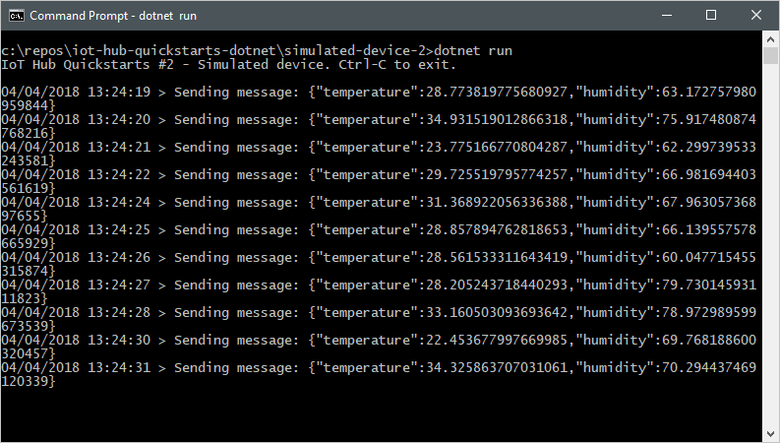
Call the direct method
The service application connects to a service-side endpoint on your IoT Hub. The application makes direct method calls to a device through your IoT hub and listens for acknowledgments. An IoT Hub service application typically runs in the cloud.
In another local terminal window, navigate to the root folder of the SDK. Then, navigate to the iothub\service\samples\getting started\InvokeDeviceMethod folder.
In the local terminal window, run the following commands to install the required libraries for the service application:
dotnet buildIn the local terminal window, run the following commands to build and run the service application.
{ServiceConnectionString}: Replace this placeholder with the IoT Hub service connection string you noted previously.{DeviceName}: Replace this placeholder with the name of the device you registered.dotnet run -- -c "{ServiceConnectionString}" -d {DeviceName}The following screenshot shows the output as the application makes a direct method call to the device and receives an acknowledgment:
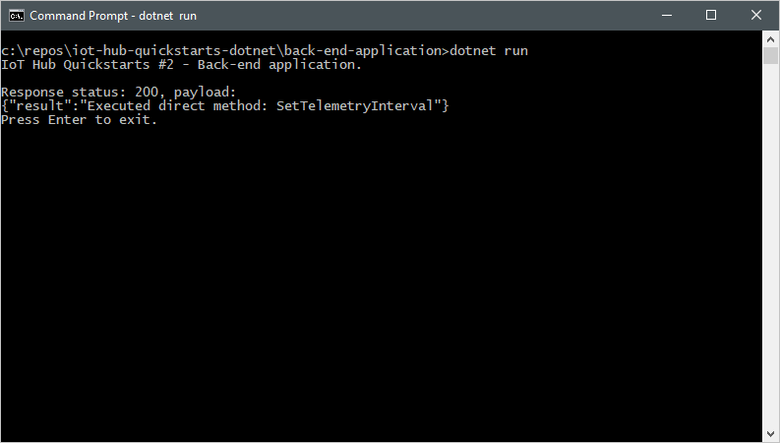
After you run the service application, you see a message in the local terminal window running the simulated device, and the rate at which it sends messages changes:
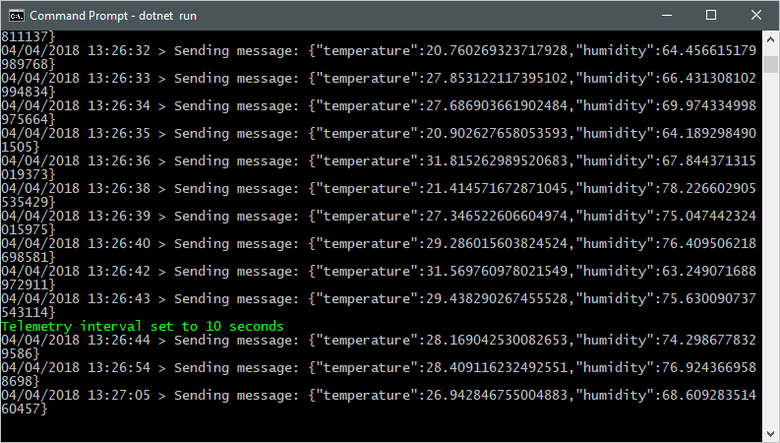
This quickstart uses two Java applications:
- A simulated device application that responds to direct methods called from a back-end application.
- A service application that calls the direct method on the simulated device.
Prerequisites
An Azure account with an active subscription. Create one for free.
Java SE Development Kit 8. In Java long-term support for Azure and Azure Stack, under Long-term support, select Java 8.
You can verify the current version of Java on your development machine using the following command:
java -version-
You can verify the current version of Maven on your development machine using the following command:
mvn --version Clone or download the Azure IoT Samples for Java from GitHub.
Make sure that port 8883 is open in your firewall. The device sample in this quickstart uses MQTT protocol, which communicates over port 8883. This port might be blocked in some corporate and educational network environments. For more information and ways to work around this issue, see the Connect to IoT Hub section of Communicate with an IoT hub using the MQTT protocol.
Use the Bash environment in Azure Cloud Shell. For more information, see Get started with Azure Cloud Shell.
If you prefer to run CLI reference commands locally, install the Azure CLI. If you're running on Windows or macOS, consider running Azure CLI in a Docker container. For more information, see How to run the Azure CLI in a Docker container.
If you're using a local installation, sign in to the Azure CLI by using the az login command. To finish the authentication process, follow the steps displayed in your terminal. For other sign-in options, see Authenticate to Azure using Azure CLI.
When you're prompted, install the Azure CLI extension on first use. For more information about extensions, see Use and manage extensions with the Azure CLI.
Run az version to find the version and dependent libraries that are installed. To upgrade to the latest version, run az upgrade.
Note
This article uses the newest version of the Azure IoT extension, called azure-iot. The legacy version is called azure-cli-iot-ext. You should only have one version installed at a time. You can use the command az extension list to validate the currently installed extensions.
Use az extension remove --name azure-cli-iot-ext to remove the legacy version of the extension.
Use az extension add --name azure-iot to add the new version of the extension.
To see what extensions are currently installed, use az extension list.
Create an IoT hub
In this section, you use Azure CLI to create an IoT hub and a resource group. An Azure resource group is a logical container into which Azure resources are deployed and managed. An IoT hub acts as a central message hub for bi-directional communication between your IoT application and the devices.
If you already have an IoT hub in your Azure subscription, you can skip this section.
To create an IoT hub and a resource group:
Launch your CLI app. To run the CLI commands in the rest of this article, copy the command syntax, paste it into your CLI app, edit variable values, and press
Enter.- If you're using Cloud Shell, select the Try It button on the CLI commands to launch Cloud Shell in a split browser window. Or you can open the Cloud Shell in a separate browser tab.
- If you're using Azure CLI locally, start your CLI console app and sign in to Azure CLI.
Run az extension add to install or upgrade the azure-iot extension to the current version.
az extension add --upgrade --name azure-iotIn your CLI app, run the az group create command to create a resource group. The following command creates a resource group named MyResourceGroup in the eastus location.
Note
Optionally, you can set a different location. To see available locations, run
az account list-locations. This quickstart uses eastus as shown in the example command.az group create --name MyResourceGroup --location eastusRun the az iot hub create command to create an IoT hub. It might take a few minutes to create an IoT hub.
YourIoTHubName. Replace this placeholder and the surrounding braces in the following command, using the name you chose for your IoT hub. An IoT hub name must be globally unique in Azure. Use your IoT hub name in the rest of this quickstart wherever you see the placeholder.
az iot hub create --resource-group MyResourceGroup --name {YourIoTHubName}
Register a device
A device must be registered with your IoT hub before it can connect. In this section, you use Azure CLI to create a device identity.
If you already have a device registered in your IoT hub, you can skip this section.
To create a device identity:
Run the az iot hub device-identity create command in your CLI shell. This command creates the device identity.
YourIoTHubName. Replace this placeholder and the surrounding braces in the following command, using the name you chose for your IoT hub. An IoT hub name must be globally unique in Azure.
myDevice. You can use this name for the device ID throughout this article, or provide a different device name.
az iot hub device-identity create --device-id myDevice --hub-name {YourIoTHubName}Run the az iot hub device-identity connection-string show command.
az iot hub device-identity connection-string show --device-id myDevice --hub-name {YourIoTHubName}The connection string output is in the following format:
HostName=<your IoT Hub name>.azure-devices.net;DeviceId=<your device id>;SharedAccessKey=<some value>Save the connection string in a secure location.
Note
Keep your CLI app open. You use it in later steps.
Retrieve the service connection string
You also need a service connection string to enable the back-end application to connect to your IoT hub and retrieve the messages. The following command retrieves the service connection string for your IoT hub:
YourIoTHubName: Replace this placeholder in the following command with the name you chose for your IoT hub.
az iot hub connection-string show --policy-name service --hub-name {YourIoTHubName} --output table
Make a note of the service connection string, which looks like:
HostName={YourIoTHubName}.azure-devices.net;SharedAccessKeyName=service;SharedAccessKey={YourSharedAccessKey}
You use this value later in the quickstart. This service connection string is different from the device connection string you noted in the previous step.
Simulate a device
The simulated device application connects to a device-specific endpoint on your IoT hub, sends simulated telemetry, and listens for direct method calls from your hub. In this quickstart, the direct method call from the hub tells the device to change the interval at which it sends telemetry. The simulated device sends an acknowledgment back to your hub after it executes the direct method.
In a local terminal window, navigate to the root folder of the sample Java project. Then navigate to the iot-hub\Quickstarts\simulated-device-2 folder.
Open the src/main/java/com/microsoft/docs/iothub/samples/SimulatedDevice.java file in a text editor of your choice.
Replace the value of the
connStringvariable with the device connection string you made a note of earlier. Then save your changes to SimulatedDevice.java.In the local terminal window, run the following commands to install the required libraries and build the simulated device application:
mvn clean packageIn the local terminal window, run the following commands to run the simulated device application:
java -jar target/simulated-device-2-1.0.0-with-deps.jarThe following screenshot shows the output as the simulated device application sends telemetry to your IoT hub:
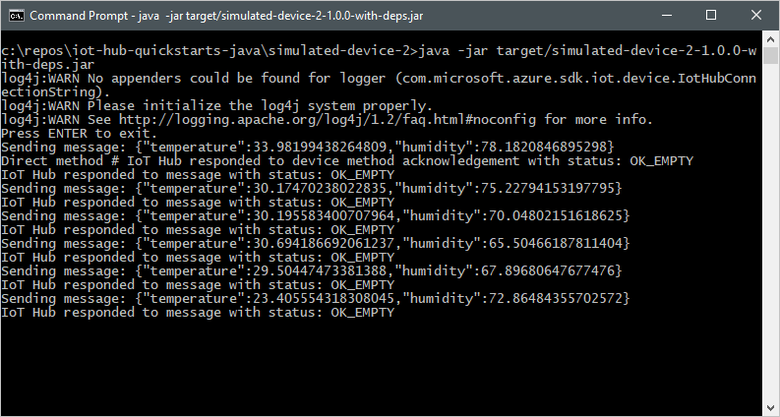
Call the direct method
The back-end application connects to a service-side endpoint on your IoT Hub. The application makes direct method calls to a device through your IoT hub and listens for acknowledgments. An IoT Hub back-end application typically runs in the cloud.
In another local terminal window, navigate to the root folder of the sample Java project. Then navigate to the iot-hub\Quickstarts\back-end-application folder.
Open the src/main/java/com/microsoft/docs/iothub/samples/BackEndApplication.java file in a text editor of your choice.
Replace the value of the
iotHubConnectionStringvariable with the service connection string you made a note of earlier. Then save your changes to BackEndApplication.java.In the local terminal window, run the following commands to install the required libraries and build the back-end application:
mvn clean packageIn the local terminal window, run the following commands to run the back-end application:
java -jar target/back-end-application-1.0.0-with-deps.jarThe following screenshot shows the output as the application makes a direct method call to the device and receives an acknowledgment:
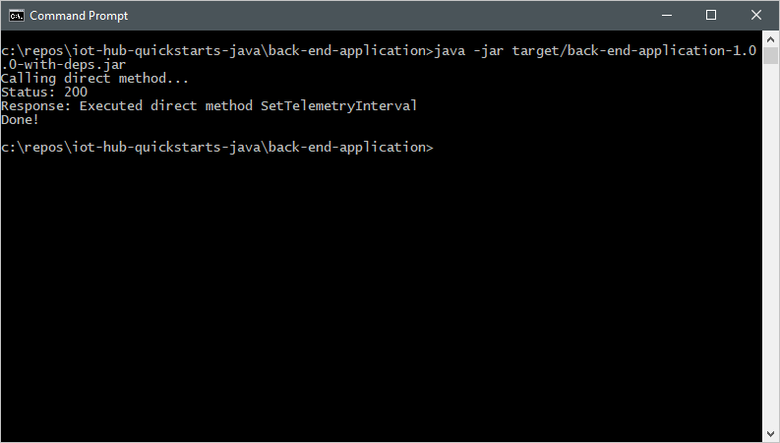
After you run the back-end application, you see a message in the local terminal window running the simulated device, and the rate at which it sends messages changes:
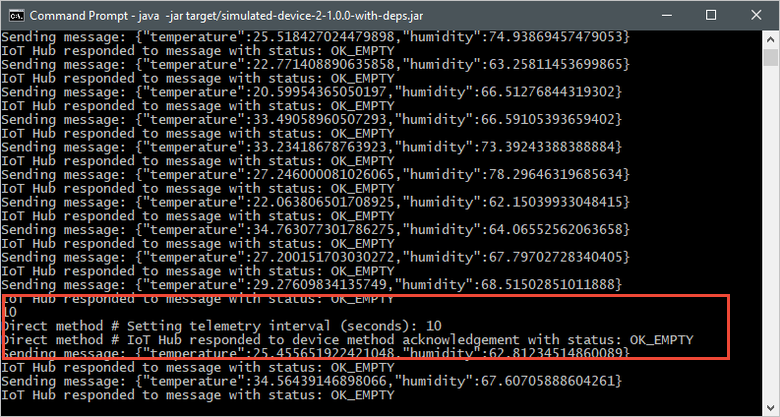
This quickstart uses two Node.js applications:
- A simulated device application that responds to direct methods called from a back-end application. To receive the direct method calls, this application connects to a device-specific endpoint on your IoT hub.
- A back-end application that calls the direct methods on the simulated device. To call a direct method on a device, this application connects to a service-specific endpoint on your IoT hub.
Prerequisites
An Azure account with an active subscription. Create one for free.
-
You can verify the current version of Node.js on your development machine using the following command:
node --version Clone or download the Azure IoT Node.js samples from GitHub.
Make sure that port 8883 is open in your firewall. The device sample in this quickstart uses MQTT protocol, which communicates over port 8883. This port might be blocked in some corporate and educational network environments. For more information and ways to work around this issue, see the Connect to IoT Hub section of Communicate with an IoT hub using the MQTT protocol.
Use the Bash environment in Azure Cloud Shell. For more information, see Get started with Azure Cloud Shell.
If you prefer to run CLI reference commands locally, install the Azure CLI. If you're running on Windows or macOS, consider running Azure CLI in a Docker container. For more information, see How to run the Azure CLI in a Docker container.
If you're using a local installation, sign in to the Azure CLI by using the az login command. To finish the authentication process, follow the steps displayed in your terminal. For other sign-in options, see Authenticate to Azure using Azure CLI.
When you're prompted, install the Azure CLI extension on first use. For more information about extensions, see Use and manage extensions with the Azure CLI.
Run az version to find the version and dependent libraries that are installed. To upgrade to the latest version, run az upgrade.
Note
This article uses the newest version of the Azure IoT extension, called azure-iot. The legacy version is called azure-cli-iot-ext. You should only have one version installed at a time. You can use the command az extension list to validate the currently installed extensions.
Use az extension remove --name azure-cli-iot-ext to remove the legacy version of the extension.
Use az extension add --name azure-iot to add the new version of the extension.
To see what extensions are currently installed, use az extension list.
Create an IoT hub
In this section, you use Azure CLI to create an IoT hub and a resource group. An Azure resource group is a logical container into which Azure resources are deployed and managed. An IoT hub acts as a central message hub for bi-directional communication between your IoT application and the devices.
If you already have an IoT hub in your Azure subscription, you can skip this section.
To create an IoT hub and a resource group:
Launch your CLI app. To run the CLI commands in the rest of this article, copy the command syntax, paste it into your CLI app, edit variable values, and press
Enter.- If you're using Cloud Shell, select the Try It button on the CLI commands to launch Cloud Shell in a split browser window. Or you can open the Cloud Shell in a separate browser tab.
- If you're using Azure CLI locally, start your CLI console app and sign in to Azure CLI.
Run az extension add to install or upgrade the azure-iot extension to the current version.
az extension add --upgrade --name azure-iotIn your CLI app, run the az group create command to create a resource group. The following command creates a resource group named MyResourceGroup in the eastus location.
Note
Optionally, you can set a different location. To see available locations, run
az account list-locations. This quickstart uses eastus as shown in the example command.az group create --name MyResourceGroup --location eastusRun the az iot hub create command to create an IoT hub. It might take a few minutes to create an IoT hub.
YourIoTHubName. Replace this placeholder and the surrounding braces in the following command, using the name you chose for your IoT hub. An IoT hub name must be globally unique in Azure. Use your IoT hub name in the rest of this quickstart wherever you see the placeholder.
az iot hub create --resource-group MyResourceGroup --name {YourIoTHubName}
Register a device
A device must be registered with your IoT hub before it can connect. In this section, you use Azure CLI to create a device identity.
If you already have a device registered in your IoT hub, you can skip this section.
To create a device identity:
Run the az iot hub device-identity create command in your CLI shell. This command creates the device identity.
YourIoTHubName. Replace this placeholder and the surrounding braces in the following command, using the name you chose for your IoT hub. An IoT hub name must be globally unique in Azure.
myDevice. You can use this name for the device ID throughout this article, or provide a different device name.
az iot hub device-identity create --device-id myDevice --hub-name {YourIoTHubName}Run the az iot hub device-identity connection-string show command.
az iot hub device-identity connection-string show --device-id myDevice --hub-name {YourIoTHubName}The connection string output is in the following format:
HostName=<your IoT Hub name>.azure-devices.net;DeviceId=<your device id>;SharedAccessKey=<some value>Save the connection string in a secure location.
Note
Keep your CLI app open. You use it in later steps.
Retrieve the service connection string
You also need your IoT hub's service connection string to enable the back-end application to connect to your IoT hub and retrieve the messages. The following command retrieves the service connection string for your IoT hub:
YourIoTHubName: Replace this placeholder in the following command with the name you chose for your IoT hub.
az iot hub connection-string show \
--policy-name service --hub-name {YourIoTHubName} --output table
Make a note of the service connection string, which looks like:
HostName={YourIoTHubName}.azure-devices.net;SharedAccessKeyName=service;SharedAccessKey={YourSharedAccessKey}
You use this value later in the quickstart. This service connection string is different from the device connection string you noted in the previous step.
Simulate a device
The simulated device application connects to a device-specific endpoint on your IoT hub, sends simulated telemetry, and listens for direct method calls from your hub. In this quickstart, the direct method call from the hub tells the device to change the interval at which it sends telemetry. The simulated device sends an acknowledgment back to your hub after it executes the direct method.
In a local terminal window, navigate to the root folder of the sample Node.js project. Then navigate to the iot-hub\Quickstarts\simulated-device-2 folder.
Open the SimulatedDevice.js file in a text editor of your choice.
Replace the value of the
connectionStringvariable with the device connection string you made a note of earlier. Then save your changes to SimulatedDevice.js.In the local terminal window, run the following commands to install the required libraries and run the simulated device application:
npm install node SimulatedDevice.jsThe following screenshot shows the output as the simulated device application sends telemetry to your IoT hub:
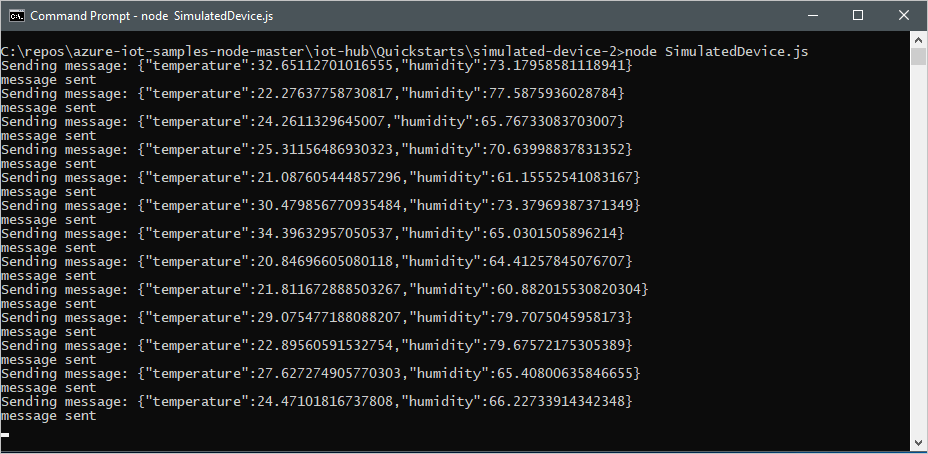
Call the direct method
The back-end application connects to a service-side endpoint on your IoT hub. The application makes direct method calls to a device through your IoT hub and listens for acknowledgments. An IoT Hub back-end application typically runs in the cloud.
In another local terminal window, navigate to the root folder of the sample Node.js project. Then navigate to the iot-hub\Quickstarts\back-end-application folder.
Open the BackEndApplication.js file in a text editor of your choice.
Replace the value of the
connectionStringvariable with the service connection string you made a note of earlier. Then save your changes to BackEndApplication.js.In the local terminal window, run the following commands to install the required libraries and run the back-end application:
npm install node BackEndApplication.jsThe following screenshot shows the output as the application makes a direct method call to the device and receives an acknowledgment:
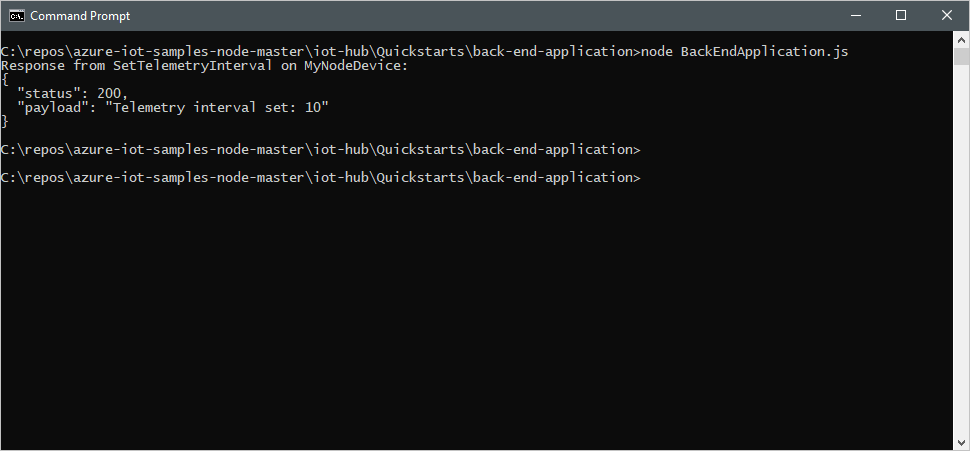
After you run the back-end application, you see a message in the local terminal window running the simulated device, and the rate at which it sends messages changes:
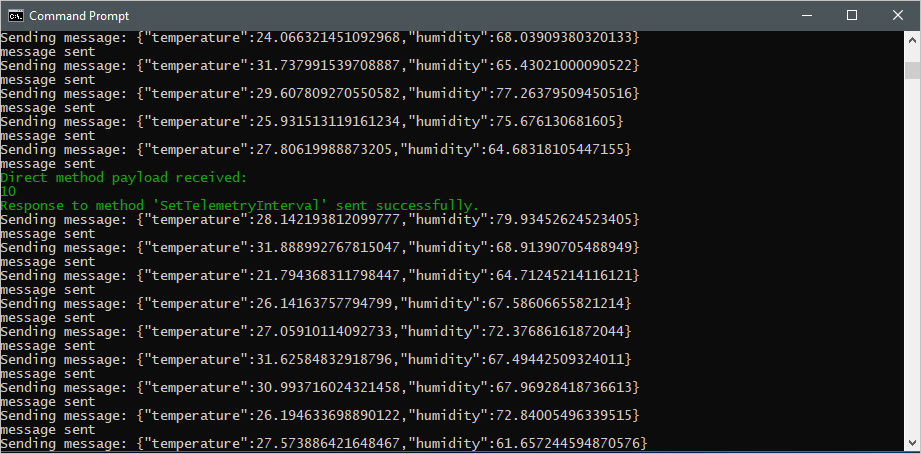
This quickstart uses two Python applications:
- A simulated device application that responds to direct methods called from a back-end application.
- A back-end application that calls the direct methods on the simulated device.
Prerequisites
An Azure account with an active subscription. Create one for free.
Python 3.7+. For other versions of Python supported, see Azure IoT Device Features.
Clone or download the Azure IoT Python samples from GitHub.
Make sure that port 8883 is open in your firewall. The device sample in this quickstart uses MQTT protocol, which communicates over port 8883. This port might be blocked in some corporate and educational network environments. For more information and ways to work around this issue, see the Connect to IoT Hub section of Communicate with an IoT hub using the MQTT protocol.
Use the Bash environment in Azure Cloud Shell. For more information, see Get started with Azure Cloud Shell.
If you prefer to run CLI reference commands locally, install the Azure CLI. If you're running on Windows or macOS, consider running Azure CLI in a Docker container. For more information, see How to run the Azure CLI in a Docker container.
If you're using a local installation, sign in to the Azure CLI by using the az login command. To finish the authentication process, follow the steps displayed in your terminal. For other sign-in options, see Authenticate to Azure using Azure CLI.
When you're prompted, install the Azure CLI extension on first use. For more information about extensions, see Use and manage extensions with the Azure CLI.
Run az version to find the version and dependent libraries that are installed. To upgrade to the latest version, run az upgrade.
Note
This article uses the newest version of the Azure IoT extension, called azure-iot. The legacy version is called azure-cli-iot-ext. You should only have one version installed at a time. You can use the command az extension list to validate the currently installed extensions.
Use az extension remove --name azure-cli-iot-ext to remove the legacy version of the extension.
Use az extension add --name azure-iot to add the new version of the extension.
To see what extensions are currently installed, use az extension list.
Create an IoT hub
In this section, you use Azure CLI to create an IoT hub and a resource group. An Azure resource group is a logical container into which Azure resources are deployed and managed. An IoT hub acts as a central message hub for bi-directional communication between your IoT application and the devices.
If you already have an IoT hub in your Azure subscription, you can skip this section.
To create an IoT hub and a resource group:
Launch your CLI app. To run the CLI commands in the rest of this article, copy the command syntax, paste it into your CLI app, edit variable values, and press
Enter.- If you're using Cloud Shell, select the Try It button on the CLI commands to launch Cloud Shell in a split browser window. Or you can open the Cloud Shell in a separate browser tab.
- If you're using Azure CLI locally, start your CLI console app and sign in to Azure CLI.
Run az extension add to install or upgrade the azure-iot extension to the current version.
az extension add --upgrade --name azure-iotIn your CLI app, run the az group create command to create a resource group. The following command creates a resource group named MyResourceGroup in the eastus location.
Note
Optionally, you can set a different location. To see available locations, run
az account list-locations. This quickstart uses eastus as shown in the example command.az group create --name MyResourceGroup --location eastusRun the az iot hub create command to create an IoT hub. It might take a few minutes to create an IoT hub.
YourIoTHubName. Replace this placeholder and the surrounding braces in the following command, using the name you chose for your IoT hub. An IoT hub name must be globally unique in Azure. Use your IoT hub name in the rest of this quickstart wherever you see the placeholder.
az iot hub create --resource-group MyResourceGroup --name {YourIoTHubName}
Register a device
A device must be registered with your IoT hub before it can connect. In this section, you use Azure CLI to create a device identity.
If you already have a device registered in your IoT hub, you can skip this section.
To create a device identity:
Run the az iot hub device-identity create command in your CLI shell. This command creates the device identity.
YourIoTHubName. Replace this placeholder and the surrounding braces in the following command, using the name you chose for your IoT hub. An IoT hub name must be globally unique in Azure.
myDevice. You can use this name for the device ID throughout this article, or provide a different device name.
az iot hub device-identity create --device-id myDevice --hub-name {YourIoTHubName}Run the az iot hub device-identity connection-string show command.
az iot hub device-identity connection-string show --device-id myDevice --hub-name {YourIoTHubName}The connection string output is in the following format:
HostName=<your IoT Hub name>.azure-devices.net;DeviceId=<your device id>;SharedAccessKey=<some value>Save the connection string in a secure location.
Note
Keep your CLI app open. You use it in later steps.
Retrieve the service connection string
You also need a service connection string to enable the back-end application to connect to your IoT hub and retrieve the messages. The following command retrieves the service connection string for your IoT hub:
YourIoTHubName: Replace this placeholder in the following command with the name you choose for your IoT hub.
az iot hub connection-string show \
--policy-name service \
--hub-name {YourIoTHubName} \
--output table
Make a note of the service connection string, which looks like:
HostName={YourIoTHubName}.azure-devices.net;SharedAccessKeyName=service;SharedAccessKey={YourSharedAccessKey}
You use this value later in the quickstart. This service connection string is different from the device connection string you noted in the previous step.
Simulate a device
The simulated device application connects to a device-specific endpoint on your IoT hub, sends simulated telemetry, and listens for direct method calls from your hub. In this quickstart, the direct method call from the hub tells the device to change the interval at which it sends telemetry. The simulated device sends an acknowledgment back to your hub after it executes the direct method.
In a local terminal window, navigate to the root folder of the sample Python project. Then navigate to the iot-hub\Quickstarts\simulated-device-2 folder.
Open the SimulatedDeviceSync.py file in a text editor of your choice.
Replace the value of the
CONNECTION_STRINGvariable with the device connection string you made a note of earlier. Then save your changes to SimulatedDeviceSync.py.In the local terminal window, run the following commands to install the required libraries for the simulated device application:
pip install azure-iot-deviceIn the local terminal window, run the following commands to run the simulated device application:
python SimulatedDeviceSync.pyThe following screenshot shows the output as the simulated device application sends telemetry to your IoT hub:
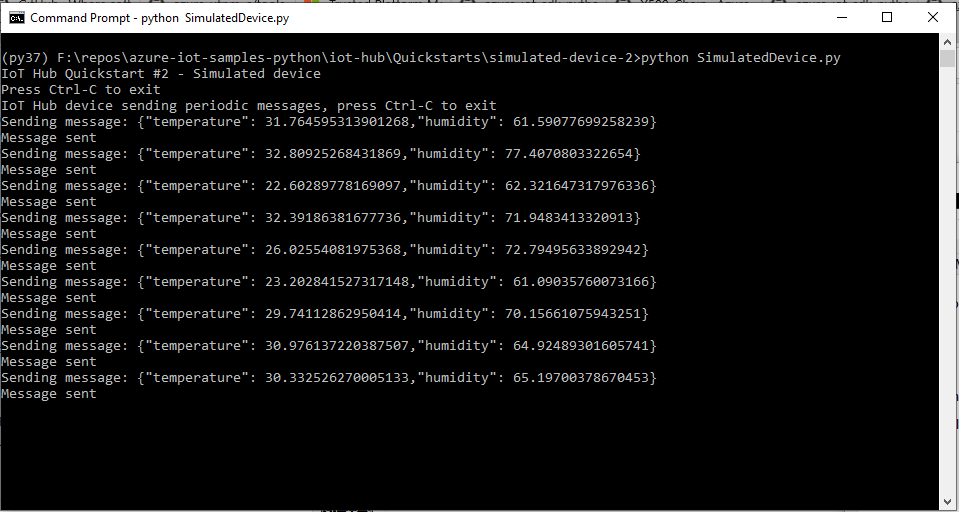
Call the direct method
The back-end application connects to a service-side endpoint on your IoT Hub. The application makes direct method calls to a device through your IoT hub and listens for acknowledgments. An IoT Hub back-end application typically runs in the cloud.
In another local terminal window, navigate to the root folder of the sample Python project. Then navigate to the iot-hub\Quickstarts\back-end-application folder.
Open the BackEndApplication.py file in a text editor of your choice.
Replace the value of the
CONNECTION_STRINGvariable with the service connection string you made a note of earlier. Then save your changes to BackEndApplication.py.In the local terminal window, run the following commands to install the required libraries for the simulated device application:
pip install azure-iot-hubIn the local terminal window, run the following commands to run the back-end application:
python BackEndApplication.pyThe following screenshot shows the output as the application makes a direct method call to the device and receives an acknowledgment:
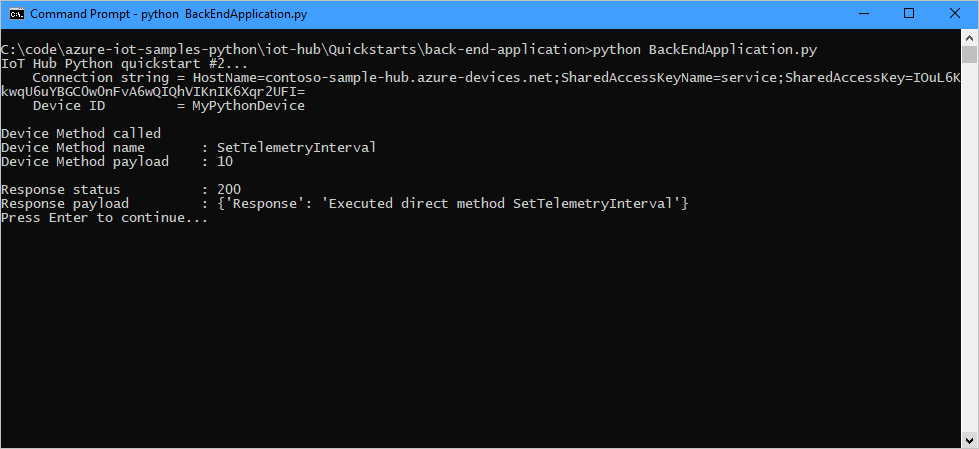
After you run the back-end application, you see a message in the console window running the simulated device, and the rate at which it sends messages changes:
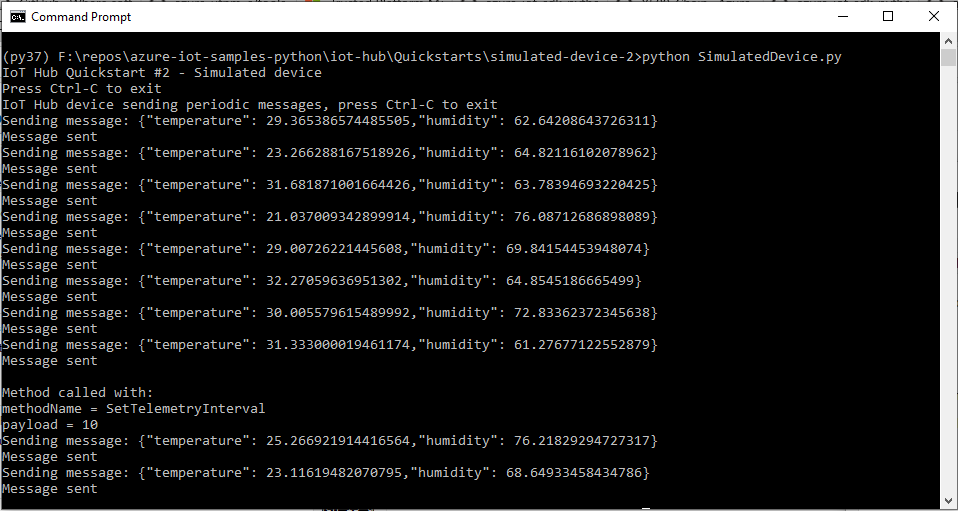
Clean up resources
If you're continuing to the next recommended article, you can keep the resources you already created and reuse them.
Otherwise, you can delete the Azure resources created in this article to avoid charges.
Important
Deleting a resource group is irreversible. The resource group and all the resources contained in it are permanently deleted. Make sure that you don't accidentally delete the wrong resource group or resources. If you created the IoT hub inside an existing resource group that contains resources you want to keep, only delete the IoT Hub resource itself instead of deleting the resource group.
To delete a resource group by name:
Sign in to the Azure portal and select Resource groups.
In the Filter for any field textbox, type the name of the resource group containing your IoT hub.
In the result list, select the resource group containing your IoT hub.
In the working pane for the resource group, select Delete resource group from the command bar.
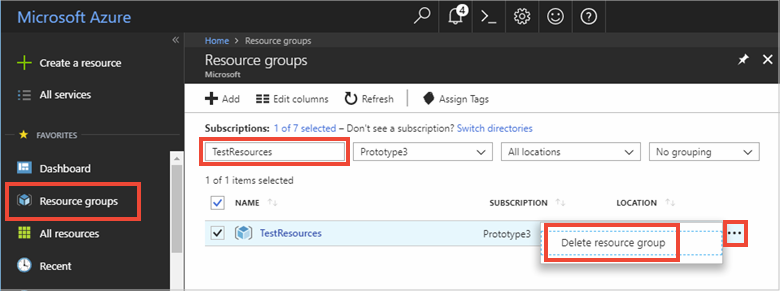
You're asked to confirm the deletion of the resource group. Type the name of your resource group again to confirm, and then select Delete. After a few moments, the resource group and all of its contained resources are deleted.
Next steps
In this quickstart, you called a direct method on a device from a service application, and responded to the direct method call in a simulated device application.
To learn how to route device-to-cloud messages to different destinations in the cloud, continue to the next tutorial.
